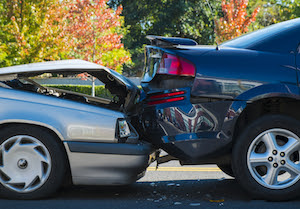 It’s unfortunate, but rear-end collisions are common. If you’re out on the road, here’s how to protect yourself as well as how to avoid causing one.
It’s unfortunate, but rear-end collisions are common. If you’re out on the road, here’s how to protect yourself as well as how to avoid causing one.
Maintain A Safe Following Distance
Always maintain a safe driving distance from other vehicles on the road. This usually means at least two car-lengths. Alternatively, you can use the DMV’s 3-second rule. Basically, this means choose an object near the road ahead to use as a fixed reference point. This could be a sign, a tree, or some other landmark.
As soon as the rear end of the vehicle in front of you passes this object, start counting, “one thousand one, one thousand two, one thousand three.” If you pass the object before you finish counting, you’re too close to the vehicle in front of you. Slow down and try again with the next object.
Increase Your Following Distance When It’s Necessary
When it’s raining, snowing, or when there is an accident, or when the driving conditions are otherwise difficult or abnormal, maintain a farther-than-normal distance. You might use a “5-second” or “10-second” rule instead of a 3-second rule.
Be Aware Of Your Surroundings
These personal injury lawyers have seen the effects and aftermath of vehicles following too closely and of people not paying attention to their surroundings. You should always know where you are on the road. Never stray into another driver’s blind spot, and get into the habit of checking your mirrors frequently when you drive.
When you come to a stop, leave enough space between you and the car in front of you so that you can see the vehicle’s license plate, rear bumper, and wheels. Usually, this gives you enough space to maneuver around them if you have to.
Avoid stopping so close to the vehicle in front of you that you cannot see the pavement between your vehicle and the vehicle in front of you. This indicates that you have stopped too close to the vehicle in front of you. When traffic starts moving again, keep a slow, and safe, distance and try to stop a little farther away at the next stop.
Be Predictable
A predictable driver is one that’s not going to surprise anyone else on the road. Likewise, if you’re predictable, you’re unlikely to be surprised. By always using turn signals, pausing before turning, and going the speed limit, signaling what you’re about to do on the road, and otherwise being courteous to other drivers, you minimize the risk of getting into an accident.
For example, rather than slam on your brakes at a stop sign or light, gradually slow down as you approach a stop sign, light, or when you’re preparing to turn.
Activate your turn signal ahead of a lane change, and give other vehicles at least 2 car-length’s warning before making a turn or a lane-change.
Check your signal lights frequently to make sure they’re in good working order. Your headlights, brake lights and turn signals should all be working without any problems.
Travis Slattery works as an accident investigator. He likes to share his insights online and has previously written for road safety related blogs.

